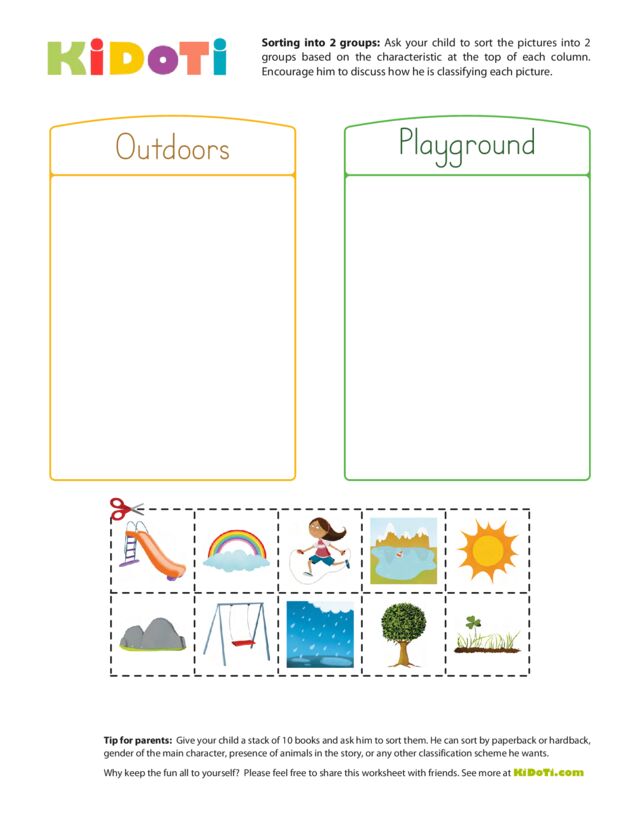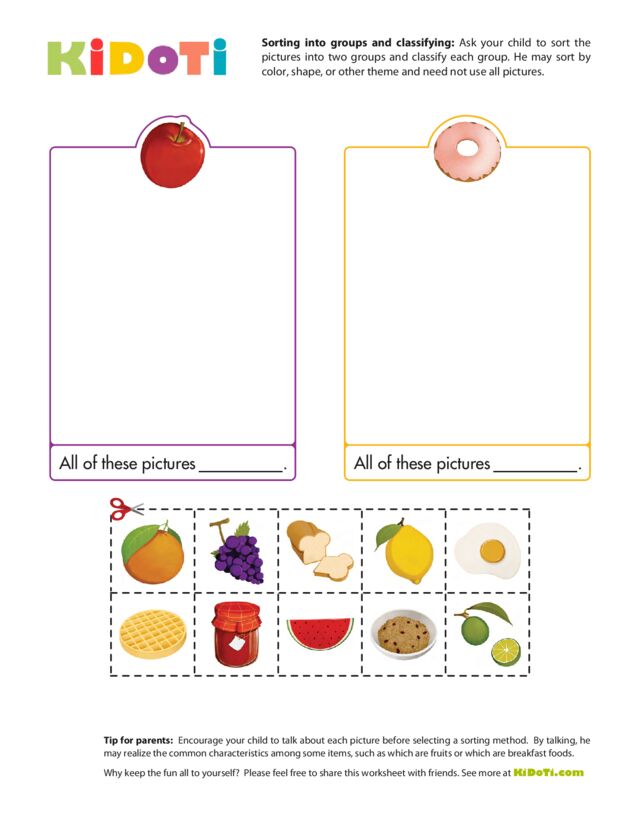Sorting numbers ( grouping items according to shared characteristics, such as shape, color or size) requires strong analytical and reasoning skills. As your child completes these worksheets, ask him to discuss the reasoning behind his sorting system, as talking aloud will encourage him to thoughtfully consider each picture and the overarching theme of the pictures he groups together.
More about the importance of sorting activities in kindergarten
Sorting activities help children develop logical reasoning skills because they require children to analyze a group of items and observe obvious characteristics. Each time your child completes a sorting activity, he will gain valuable experience making observations and sorting accordingly. This ability to sort and classify is important because your child can apply this skill set to many different areas. For example, when he enters a crowded playground, he will be able to discern that the younger children are playing by the swings, for example, while the older children are playing on the monkey bars, and then he can comfortably join the appropriate group.
There’s rarely one right answer in sorting and classifying activities
When children engage in sorting activities or classifying activities, there is rarely one correct answer. When sorting a large bowl of buttons, for example, I have seen children put the one blue button in the bowl into its own group and then lump all the remaining buttons in a different pile. In these cases, the sorting method was “blue buttons in this pile, different colored buttons in that pile.” Although it results in two sorted piles that contain very different numbers of items, that sorting system is entirely permissible. A moment later, a different child may take out the same large bowl of buttons and categorize them according to material, sorting all the metal buttons into one pile and all the plastic buttons in a different file. As with the first classification system, this classification method is also entirely correct.
Activities to complement sorting and classifying worksheets
Sorting and classifying worksheets are an engaging way to help your child learn how to explain his sorting method, since they require him to add a classification or title to each group of sorted items.
- In order for children to properly complete classifying worksheets, it is important for them to be able to understand the different terms they can use to label each group. When your child builds with blocks, write labels such as door, floor, and garage on post-it notes and encourage him to label his building. Or, when reading a picture book to your child, ask him point to specific items on the page such as “the hat,” “the swing” or “the teddy bear.” When you finish reading, challenge your child to classify other items in his room such as books, toy trains, and stuffed animals.
- Basic physical characteristics like eye color, hair color, height and gender are simple ways for children to classify people. To help your child get comfortable with these classification systems, stand in front of a mirror with your child and take turns saying things that are the same or different in your appearances. Do you have the same color eyes? Who is taller?
- Colors are also a great classification tool, since nearly every item has at least one observable color. To help your child practice classifying items by color, challenge him to stand in the middle of his room and name as many items as he can that have a certain color. Or, after getting dressed, encourage your child to touch all the clothing on his body that have a certain color in them and explain his classification system by saying why he is touching the clothing items that he is.
- When getting dressed in the morning, explain to your child what classification criteria you look for when selecting clothes for him to wear. Items with the same color? The same shape? The same size? Then turn him lose in his closet to find clothes that match your classification system. Or, let your child select his own clothes and then explain to you why he picked each item. Encourage him to articulate the identifying characteristics of each item that caught his attention.
- Let your child sort your pocket change each night into small, clear jars. You child could complete this sorting activity by sorting the coins by denomination, color (pennies in one jar, all other coins in a different jar) or by size (small pennies and dimes in one jar and large nickels and quarters in a different jar).
- Make a personalized “Match Game” by printing doubles of family pictures. Put 3 or 4 sets of matching cards face-down on the table and begin playing. After the game is over, have your child sort all of the photos by gender, age, hair color, or another defining characteristic.
- Let your child help you set the dinner table. Rather than set each place individually, prepare for a family-style meal by putting all plates, glasses and utensils in a jumbled pile in the middle of the table. Then ask your child to sort all dinner forks into one pile, all knives into a different pile, all glasses into a third group, etc.

